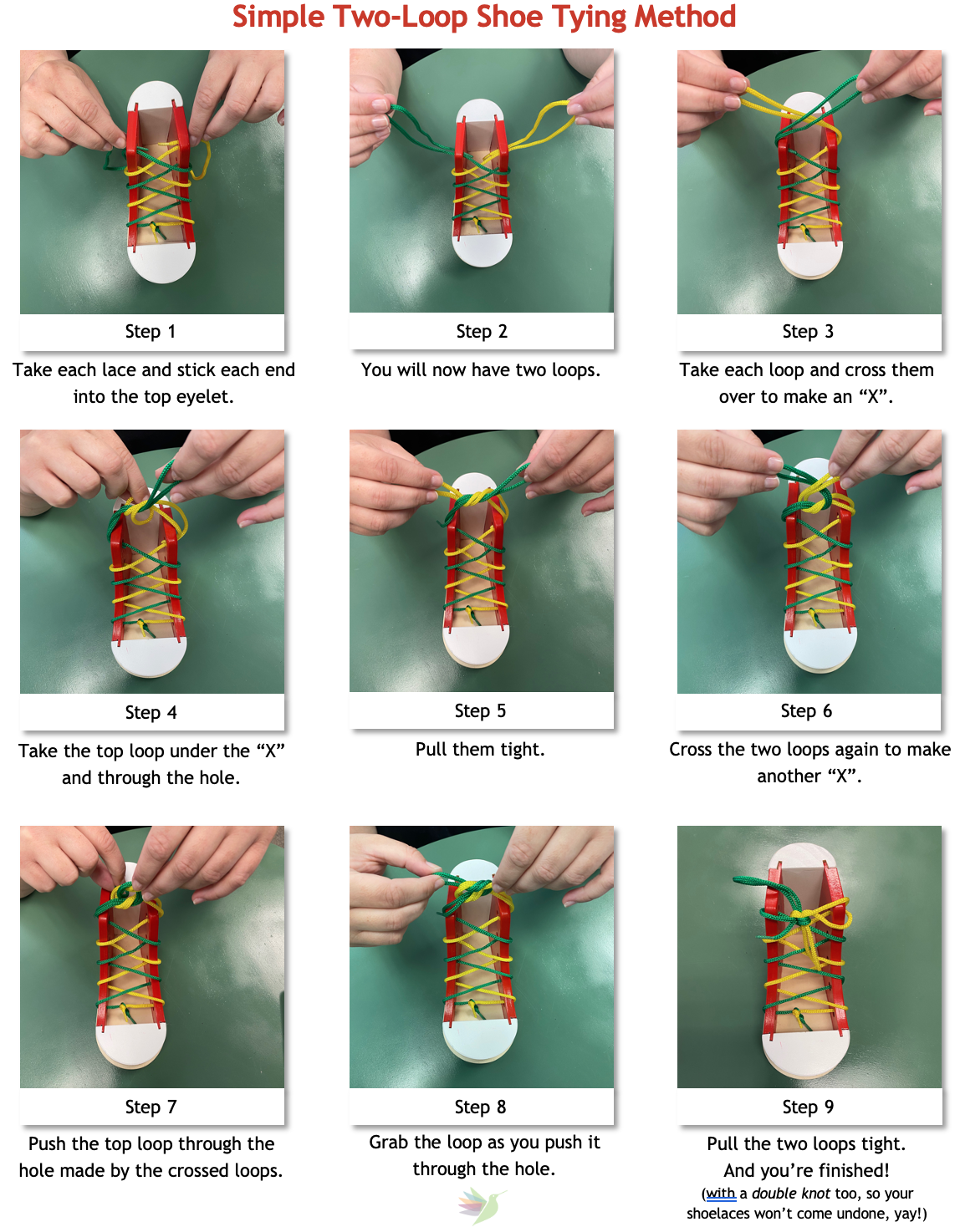Author: Rebecca O'Callaghan, M.S., OTRL, SWC
We can probably all remember learning how to tie our shoes. It is one of those activities that can take a TON of patience, time, and practice! Not to mention, there are so many different strategies on how to tie, that there really isn’t just one universal way to tie a shoe. The shoe tying process requires multiple foundational skills including: bilateral coordination, tactile discrimination, hand-eye coordination, visual perception, and motor planning. That is a long list of foundational components! Don’t worry, we will help break them down for you. But the point here is that these skills can be challenging for our kids, especially if they have difficulty with more than one of these skills. In addition, left vs. right confusion and two laces that look exactly the same can make the process even more difficult! The good news is we have included some shoe tying tips, a simple shoe-tying method, and a few favorite products that are a fun and engaging way to teach kids how to lace and tie shoes.
Foundations Needed for Shoelace Tying
Bilateral coordination: Your child needs to be able to simultaneously move both hands in a well-controlled and organized manner. Did you know that bilateral coordination requires activation on both sides of the brain?! The brain’s right and left hemispheres must work together to help process information and integrate your child’s ability to use both hands together. An example of this skill in shoe tying is using both hands to pull the laces “apart” to make the knot tight. In another example, your child also needs to be able to simultaneously move each hand in a different manner with one hand to pinch a lace while the other hand is “looping” around it.
Tactile Discrimination: Tactile discrimination allows your child to know what his/her fingers are doing by using the sense of touch. It is a way to help your brain to understand what you are touching based on things like texture, shape, or size. Tactile discrimination helps your child develop touch perception. This is the ability to feel your way around a space and know what you are touching, often without needing to use your eyes. Think digging around the bottom of that bag for a pen without looking, and...found it! With shoe tying, it can tell your child how hard to hold the laces, where the plastic end and fabric of the laces are, and even affect the speed in which he/she can tie.
Hand-Eye Coordination: Your child will need to use his/her eyes to guide his/her hands in various movements while tying, especially when he/she is a beginner.
Visual Perception: Visual perception is not how well we can see (visual acuity), but how well we can make sense of what we are seeing. With shoe tying there are two important components, visual spatial awareness and visual sequential memory. Visual spatial awareness helps your child to visualize objects from different perspectives or position. Visual sequential memory helps your child to remember, recognize, and retrieve a sequence of steps without actually looking. For example, can you remember the alphabet and write it without having to look? When training your child to tie, he/she must perceive the relationship between the two laces as when crossing or looping. Your child must also perceive the relative size of each loop or length of string to manipulate. For example, if the loop is too large or too small, it is likely that a child may be unsuccessful with completing the task.
Motor Planning: Shoe tying requires many steps. Your child needs the ability to conceptualize, plan, and execute a sequenced motor task to tie laces. Our brain uses a lot of motor planning when something is new or non-habitual. During a time of learning something new our motor planning gives us lots of feedback so that we can lay down a plan that becomes more coordinated and efficient over time. If it is practiced and routine enough or brain will lay the plan down as a physical habit so seamless that we don’t have to think about it on a conscious level.
Shoe Tying Tips!
- Shoe tying skill takes time to master, so do not rush it!
- Teach one step at a time before moving onto the next. Repetition is very important. Try to practice one step for several days, weeks, or longer if needed. Once you master one step, move onto the next step and put them together.
- Try using a shoe template mounted on a firm surface. The template can be placed on child’s lap or a tabletop for comfort while practicing. To make a template, use an old tissue box, egg carton, paper plate, or piece of cardboard (see pictures on the first page for ideas).
- Sit next to your child, facing the same way as your child when demonstrating and/or assisting.
- Using stiff laces can be easier to use than softer ones.
- Using two different colored laces can be easier when learning.
- Be sure the laces are long enough. Beginners need extra length to be successful.
- Textured shoelaces can be helpful for children that have difficulty with tactile perception.
- Generalize your child’s skills by practicing tying with things other than his/her shoes.
- There are many ways to tie shoes, so determine the easiest method for your child. If you are not sure, ask your child’s occupational therapist for a simplified method or see our simple two-loop method below!


